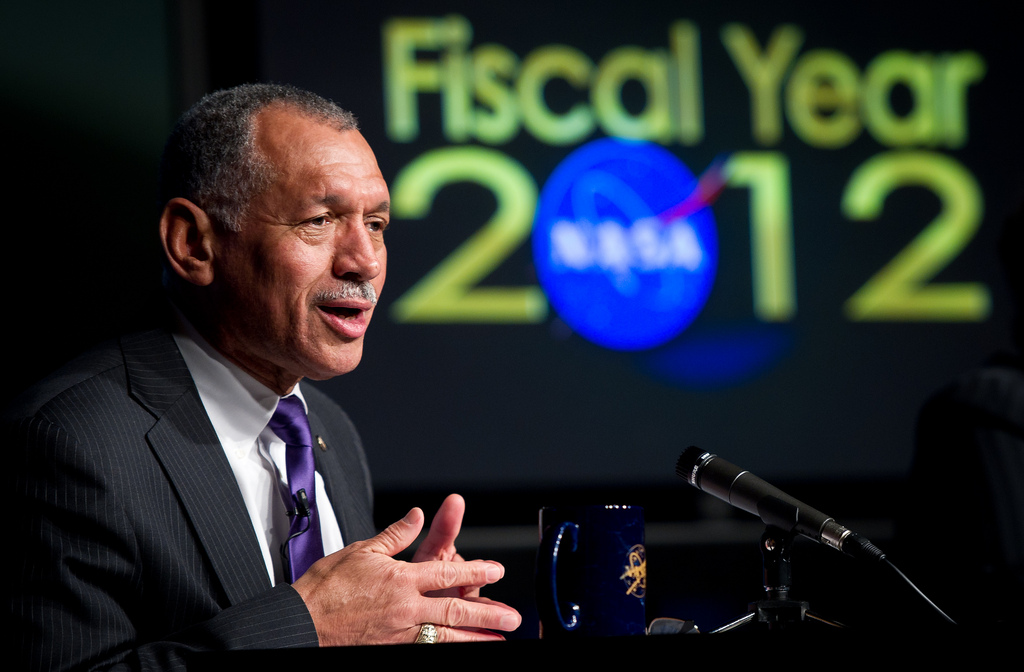President Obama Freezes NASA's Budget at 2010 Levels

This article was updated at 4:00 p.m. ET.
The Obama administration has announced its 2012 budget request, which if approved would freeze spending for NASA and other federal agencies at 2010 levels for the next fiscal year.
The 2012 budget request allocates $18.7 billion for NASA, the same amount the agency received in 2010. That's about $300 million less than NASA received in the president's 2011 budget request.
"The times today are very difficult fiscally, and we're going to live within a budget," NASA administrator Charles Bolden said at a press conference today. "What we do has to be affordable, sustainable, and it has to make sense."
The move is part of an overall five-year freeze on non-security discretionary spending that the White House is proposing.
"The fiscal realities we face require hard choices," President Barack Obama wrote in his statement on the new budget. "A decade of deficits, compounded by the effects of the recession and the steps we had to take to break it, as well as the chronic failure to confront difficult decisions, has put us on an unsustainable course. That's why my budget lays out a path for how we can pay down these debts and free the American economy from their burden."
The new budget request applies to the 2012 fiscal year, which begins Oct. 1, 2011. This preliminary proposal, however, is likely to be modified by Congress.
Get the Space.com Newsletter
Breaking space news, the latest updates on rocket launches, skywatching events and more!
Stuck in limbo
The announcement comes at a time when a federal budget for 2011 has yet to be passed. The government, including NASA, is currently operating under a stopgap measure called a continuing resolution enacted while lawmakers try to agree on a federal budget.
The current continuing resolution is set to expire on March 4. Lawmakers are preparing another continuing resolution that would tide the government over until September.
The House Appropriations Committee aims to enact big spending cuts that would reduce NASA's proposed $19 billion budget for 2011 by $578 million as part of a wider plan to trim $100 billion from the national budget, according to Space News. That would be a $303 million drop from the previous year.
Some space supporters were hoping the new 2012 budget request would increase NASA's budget and fund it at levels adequate to accomplish the goals set forth in the NASA Authorization Act passed by Congress and signed into law by the president, in October 2010. That act recommended the agency receive a yearly budget of $19.45 billion – $750 million more than the 2012 budget blueprint lays out.
"I don't know what will be in the budget, but I hope that it will be adequate to move forward exploration and commercial crew to LEO [low-Earth orbit] development," former astronaut Leroy Chiao said Friday (Feb. 11). Chiao served as member of the independent panel Obama commissioned to review NASA's plans in 2009. "These are the two most important components of forward U.S. HSF [Human Space Flight] plans."
Budget breakdown
Although the new budget blueprint would roll back overall NASA spending, it does recommend boosts for some NASA sectors, including partnerships with commercial spaceflight companies.
The 2012 request allocates $850 million for NASA to partner with American companies to provide astronaut transportation to and from the International Space Station.
The blueprint also suggests $1 billion for space technology research and developments that could pave the way for future space missions, and $5 billion for robotic solar system exploration, which would include new astronomical observatories and Earth observation programs.
The proposal recommends $2.8 billion for developing a heavy-lift rocket and crew capsule that would carry astronauts beyond low-Earth orbit. Such a vehicle is required for the trips to an asteroid and Mars that the Obama administration has pushed for.
Transitioning beyond shuttle
The space community is also looking to the 2012 budget request to offer guidance for a space agency that is trying to transition from the space shuttle era to a new future with a heightened focus on commercial spaceflight.
"The thing everyone wants is some clarity on what the next step is in building a next-generation launch vehicle for human spaceflight," said space policy expert Roger Handberg, a professor of political science at the University of Central Florida.
Handberg was doubtful that the new document would be able to accomplish that goal, though, because he said NASA remains embroiled in a debate over whether and how to abandon the Constellation program, a moon-oriented exploration vision for NASA set up under the George W. Bush administration. Obama has proposed targeting human missions to an asteroid and Mars instead.
"The battle over the carcass of Constellation will continue, which means paralysis for the agency," Handberg told SPACE.com in an e-mail last week.
"The irony is that finally an administration reaches office that is serious about commercial spaceflight but runs into the buzz saw of constituent jobs as the barrier to change," he wrote. "Merging the commercial and the NASA worlds together is the optimal solution, but that will not occur until the reality becomes clear that NASA must be allowed to rise above constituent jobs as the sole reason for having a human spaceflight program."
Following the official announcement of the new budget request, NASA will hold media briefings starting at 2 p.m. ET to discuss the ramifications for its space operations, explorations, science and other activities.
You can follow SPACE.com senior writer Clara Moskowitz on Twitter @ClaraMoskowitz.
Join our Space Forums to keep talking space on the latest missions, night sky and more! And if you have a news tip, correction or comment, let us know at: community@space.com.

Clara Moskowitz is a science and space writer who joined the Space.com team in 2008 and served as Assistant Managing Editor from 2011 to 2013. Clara has a bachelor's degree in astronomy and physics from Wesleyan University, and a graduate certificate in science writing from the University of California, Santa Cruz. She covers everything from astronomy to human spaceflight and once aced a NASTAR suborbital spaceflight training program for space missions. Clara is currently Associate Editor of Scientific American. To see her latest project is, follow Clara on Twitter.
